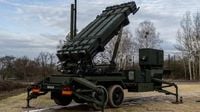Poland's military landscape is undergoing significant changes as the nation grapples with the repercussions of its extensive support for Ukraine amidst the ongoing conflict with Russia. On March 31, 2025, a top Polish military commander, Lieutenant General Maciej Klisz, raised alarms regarding the severe depletion of the country's ammunition reserves, a situation that has become increasingly concerning since the war began in 2022.
In an interview reported by Bulgarianmilitary.com, Klisz revealed that Poland's reserves have been critically affected, raising questions about the nation’s readiness to confront potential threats. Poland has been a staunch ally of Ukraine, transferring over 320 T-72 tanks, dozens of Krab self-propelled howitzers, and thousands of artillery shells to aid its neighbor in maintaining its defense against Russian forces. This support, valued in the billions of US dollars, has proven crucial for Ukraine, especially as artillery fire accounts for up to 70% of the conflict's consumption, with both sides firing tens of thousands of rounds daily, according to the Royal United Services Institute (RUSI).
By mid-2023, Poland's aid included an estimated 50,000 artillery shells, which has significantly depleted its own reserves. This depletion has forced Poland to rely on increasing domestic production and imports to replenish its stockpiles. Dariusz Lukowski, head of Poland's National Security Bureau, acknowledged this challenge but noted that the war in Ukraine also presents opportunities to rebuild military capabilities.
One of the key components of Poland's modern military arsenal is the AHS Krab self-propelled howitzer, which boasts a range of 40 km with standard ammunition and up to 55 km with long-range shells. The Krab can fire six rounds per minute, making it a formidable asset. Since its introduction in 2016, Poland has deployed over 80 of these howitzers, with plans to acquire more by 2026. However, the effectiveness of this artillery system hinges on a stable supply of 155mm ammunition, much of which has been redirected to Ukraine, leaving Polish units vulnerable.
In response to these challenges, Poland is ramping up its defense spending, committing 4.7% of its GDP to military expenditures—more than any other NATO member, including the United States. This translates to approximately 35 billion USD annually, significantly exceeding NATO's benchmark of 2% GDP. Prime Minister Donald Tusk has ambitious plans to double the military force from the current 200,000 troops to 500,000 and to train millions of reservists. Tusk's vision positions Poland as a military power capable of defending against any adversary.
To further bolster its defenses, Poland has initiated the "East Shield" project, a 2.6 billion USD initiative aimed at reinforcing borders with trenches, sensors, and up to one million anti-personnel mines, as disclosed by Deputy Defense Minister Paweł Bejda. While the state-owned PGZ group has increased ammunition production, it remains insufficient to meet the urgent demand. In November 2024, Army Recognition reported that Poland allocated 3 billion zloty (approximately 750 million USD) to expedite ammunition production, highlighting the alarmingly low reserves.
Additionally, Poland has signed contracts with suppliers from the US and Europe, including a 1.4 billion USD agreement for 155mm artillery shells announced in 2023. However, delivery timelines extend to the end of 2025, creating a security gap that adversaries could exploit. The Polish defense industry, led by companies like PGZ and WB Group, is expanding to meet domestic needs and tap into export markets. The Krab howitzer has garnered interest from Romania and Slovakia, with potential agreements in the pipeline.
Since the onset of the conflict in Ukraine, Poland has welcomed thousands of US troops and received advanced military systems such as Patriot air defense systems and Abrams tanks, solidifying its role as a frontline defense in NATO. However, the depletion of its ammunition reserves underscores a paradox: Poland's generosity towards Ukraine has strengthened Kyiv's resistance but has left Warsaw struggling to replenish its own military stock.
On April 1, 2025, Poland further solidified its defense capabilities by signing a nearly 2 billion USD agreement with the US to enhance combat readiness and logistical support for its Patriot air defense systems. This agreement is part of Poland's ongoing air force modernization strategy, which has been in effect since 2018. The Polish Ministry of Defense stated that this partnership with Washington will provide crucial technical, training, and logistical support for the Patriot systems, ensuring their effective operation.
This latest agreement follows Poland's purchase of two Patriot systems for 4.75 billion USD in 2018 and an additional order for six systems worth approximately 15 billion USD in September 2023. As Poland faces increasing threats, particularly due to its proximity to Belarus and the Russian exclave of Kaliningrad, the nation is expected to allocate 4.7% of its GDP to defense in 2025, marking a 0.6% increase from 2024.
The NATO Secretary General praised Poland's commitment to defense spending, recognizing it as a model for the alliance. However, the ongoing ammunition shortages raise critical questions about the country’s deterrent capabilities. As Poland navigates these challenges, it remains focused on rebuilding and modernizing its military forces to ensure national security in an increasingly volatile geopolitical landscape.





